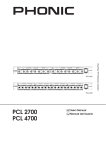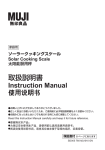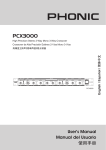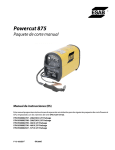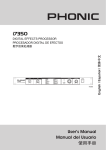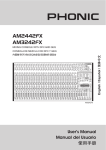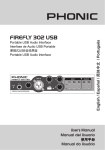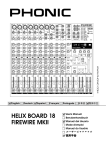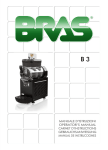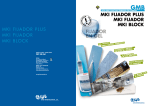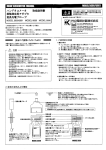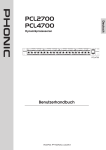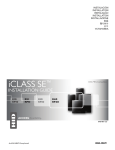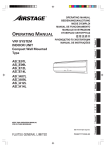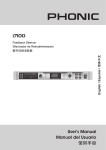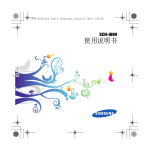Download PCL2700 PCL4700
Transcript
PCL2700 PCL4700 Singal Processors 信号处理器 PCL4700 User’s Manual Manual del Usuario 使用手册 English / Español / 简体中文 PROCESADORES DE SEÑAl PCL2700/PCL4700 Singal Processors PROCESADORES DE SEÑAl 信号处理器 CONTENTS CONTENIDO 目录 INTRODUCTION 4 INTRODUCCIÓN 10 简介 16 FEATURES 4 CARACTERÍSTICAS 10 功能 16 PRODUCT DESCRIPTION 4 DESCRIPCIÓN DEL PRODUCTO 10 控制和连接 16 EXPANDER/GATE 4 EXPANSOR/PUERTA (EXPANDER/GATE)10 扩展器/噪声门 16 COMPRESSOR 5 COMPRESOR 压缩器 17 DE-ESSER SECTION (PCL2700 ONLY) 5 11 SECCIÓN DEESSER (PCL2700 SOLAMENTE) DE-ESSER控制区(仅适用 11 于PCL2700) 17 PEAK LIMITER SECTION 6 SECCIÓN DE LIMITADOR DE PICO12 峰值限幅器控制区 18 INPUTS AND OUTPUTS 6 ENTRADAS Y SALIDAS 12 输入和输出 18 SPECIFICATIONS 7 ESPECIFICACIONES 13 规格 19 APLICACIÓN 21 应用 21 APPLICATION 21 Phonic preserves the right to improve or alter any information within this document without prior notice Phonic se reserva el derecho de mejorar o alterar cualquier información provista dentro de este documento sin previo aviso PHONIC保留不预先通知即可更新本文件的权利 V1.0 08/13/2010 IMPORTANT SAFETY INSTRUCTIONS The apparatus shall not be exposed to dripping or splashing and that no objects with liquids, such as vases, shall be placed on the apparatus. The MainS plug is used as the disconnect device, the disconnect device shall remain readily operable. Warning: the user shall not place this apparatus in the can be easily accessible. area during the operation so that the mains switch 1. read these instructions before operating this apparatus. CAUTION 2. Keep these instructions for future reference. RISK OF ELECTRIC SHOCK DO NOT OPEN 3. Heed all warnings to ensure safe operation. 4. Follow all instructions provided in this document. 5. Do not use this apparatus near water or in locations where condensation may occur. 6. clean only with dry cloth. Do not use aerosol or liquid cleaners. Unplug this apparatus before cleaning. 7. Do not block any of the ventilation openings. install in accordance with the manufacturer’s instructions. 8. Do not install near any heat sources such as radiators, heat registers, stoves, or other apparatus (including . 9. Do not defeat the safety purpose of the polarized or grounding-type plug. a polarized plug has two blades with one wider than the other. a grounding type plug has two blades and a third grounding prong. The wide blade or the third prong is provided for your safety. if the provided plug does not into your outlet, consult an electrician for replacement of the obsolete outlet. 10. Protect the power cord from being walked on or pinched particularly at plug, convenience receptacles, and the point where they exit from the apparatus. 11. only use attachments/accessories manufacturer. by the 12. Use only with a cart, stand, tripod, bracket, or table by the manufacturer, or sold with the apparatus. When a cart is used, use caution when moving the cart/apparatus combination to avoid injury from tipover. 13. Unplug this apparatus during lighting storms or when unused for long periods of time. 14. refer all servicing to service personnel. Servicing is required when the apparatus has been damaged in any way, such as power-supply cord or plug is damaged, liquid has been spilled or objects have fallen into the apparatus, the apparatus has been exposed to rain or moisture, does not operate normally, or has been dropped. caUTion: To reDUce THe riSK oF elecTric SHocK, Do noT reMoVe coVer (or BacK) no USer SerViceaBle ParTS inSiDe reFer SerVicing To QUaliFieD PerSonnel The lightning flash with arrowhead symbol, within an equilateral triangle, is intended to alert the user to the presence of uninsulated “dangerous voltage” within the product’ magnitude to constitute a risk of electric shock to persons. The exclamation point within an equilateral triangle is intended to alert the user to the presence of important operating and maintenance (servicing) instructions in the literature accompanying the appliance. WARNING: To reduce the risk of or electric shock, do not expose this apparatus to rain or moisture. CAUTION: Use of controls or adjustments or performance of procedures other than those may result in hazardous radiation exposure. INTRODUCTION Congratulations on your purchase of another quality product! We hope your PCL2700 or PCL4700 dynamic processor proves itself to be a worthwhile investment and provides you with years of dependable use. These processors were meticulously designed by skilled engineers, and should give you total control of your audio. We know how eager you are to get started, however we advise that you take the time to read through this manual before storing it in an easy to remember place for future reference. Within this manual you’ll find helpful information on the operation and treatment of your PCL unit. FEATURES l Program-adaptive compression circuitry with both hard- and soft-knee properties lIntelligent Peak/Limiting circuitry combining aspects of clip and limiter functions for more reliable protection and inaudibility for peaks l Dynamic enhancer for exciting and lively audio even through compression lExpander/gate suppression l circuit with ratio control for cleaner noise Switchable stereo coupling function lAttack and release times adjustable either automatically or manually (PCL2700 only) lIntegrated de-esser removes excessive sibilance from vocals (PCL2700 only) lClassic tube simulation for adding warmth to your sound (PCL2700 only) l 6-segment LED meters for input/output levels (5-segment on the PCL4700) l Balanced 1/4” TRS and XLR inputs and outputs lAuto l bypass function in event of power outage Ultra-low noise operation PRODUCT DESCRIPTION 1. Couple Button Pushing this button in will link the two channels of the PCL for true stereo processing. When the channels are coupled, the dynamics are then adjusted using the channel 1 controls. On the PCL4700, channels 1 and 2 can be coupled and channels 3 and 4 can be coupled – in these cases, channels 1 and 3 will act as the default control sections. The IN/OUT, SC EXT, SC MON, TUBE, DEESSER, MALE, ENHANCER, I/O METER switches and the OUTPUT, DE-ESSER LEVEL and ENHANCER LEVEL controls are unaffected, however. 1 PCL2700 1 PCL4700 EXPANDER/GATE 2. Trigger Control This control will adjust the threshold for the expander/gate function between OFF and +10 dB. The expander will set in below your selected threshold. 3. Indicators If the signal is below the value set by the Trigger control, the red LED will light up. If the signal is above the adjusted value, the green LED will light up. 4. Release Button This will allow users to determine whether the PCL will have a long or short release time, which will ultimately depend on your requirements. Push the button in for a longer release time, ideal for slowly decaying signals and signals with heavy reverb. Keep the button released for a shorter reverb time, ideal for signals with little to no reverb. 5. Gate Button The gate button will allow users to swap between the gate and expander functions. When the button is pushed in, the gate is active; when the button is released, the expander is. Use the gate function to affectively mute all signals below the selected threshold. 3 4 2 5 PCL2700 / PCL4700 7 9 11 13 17 18 21 22 4 11 13 17 18 3 6 8 10 12 14 15 2 5 6 16 19 20 23 10 PCL2700 COMPRESSOR 6. Threshold Control This control will adjust the compressor ’s threshold between -40 and +20 dB. 7. Indicators (PCL2700 only) If the signal is below the value set by the threshold control, the LED on the left will light up. If the signal is above the adjusted value, the LED on the right will. The center yellow LED refers to the Interactive Knee soft-knee range (if activated). 8. Sidechain External Button (PCL2700 only) Pushing this button in will interrupt the signal between the input and the compressor. When this is done, using the SC Return input on the rear of the device to connect an external control signal. 9. Sidechain Monitor Button (PCL2700 only) By pushing this button, the input signal from the sidechain will be linked to the audio output, thus muting the audio input signal. When the SC Monitor switch is activated, only the sidechain signal will be sent to the outputs, which will be indicated by a flashing LED. 10. Ratio Control This control will adjust the ratio of input to output, with regards to all signals that exceed the threshold by 10Db or more. The auto hard-knee/soft-knee function ensures level, inaudible activation of the compressor function. 11. Gain Reduction Display This 8 digit display (6 digit on the PCL4700) gives you a visual representation of the gain reduction currently applied to your signal (between 1 and 30 dB). 16 19 PCL4700 15. Release Control (PCL2700 only) By adjusting this control, users can select the time it will take for the compressor to disengage after the gain drops below the level set by the threshold. Users can adjust the range between 0.05 and 5 seconds. 16. Output Control This control allows users to increase and attenuate the output signal of the PCL by up to 20 dB, ensuring users can compensate for any gain loss caused by compression. 17. Level Meter This 6-segment (5-segment on the PCL4700) level meter gives users a visual indication of the incoming and outgoing audio levels between -30 and +18 dB (-24 and +18 on the PCL4700), depending on the setting of the Level Meter Input/Output Button. 18. Level Meter Input/Output Button This button allows the user to decide whether they want to see the input level (when the button is engaged) or the output level (when the button is disengaged) in the level meter. 19. In/Out Switch This button activates the corresponding channel. It also activates a “hard bypass” of the corresponding channel, meaning that – even without power – the input signal will be sent directly to the output. A common function of this button is to compare the processed and unprocessed signals instantly. DE-ESSER SECTION (PCL2700 only) The De-esser function – available on the PCL2700 – is only active if the compressor function is used. 12. Attack Control (PCL2700 only) 20. Level Control This control will allow users to determine when compression will set in after the signal level has exceeded the threshold. Adjusting this control will allow users to determine the amount of frequency suppression to be used. 13. Interactive Knee Button 21. De-esser Level Meter This button will activate the “interactive knee” function. When active, input signals that are 10dB over the threshold will be processed with ‘soft-knee’ compression. At all other times, hardknee compression will be active. The interactive knee function allows for more discreet compression of music and should be activated when inaudible compression is needed. This meter gives a visual representation of the current attenuation, between +3 and +12 dB. 14. Auto Button (PCL2700 only) By pushing this button in, the attack and release buttons on the PCL2700 will become effectively disabled. The attack and release times will then be determined automatically, according to the complexity of musical aspects of the audio received. PCL2700 / PCL4700 22. Male Switch The button will adapt the de-esser function to both male (pushed in) and female (released) voices. 23. In/Out Switch This button will turn the de-esser function off and on. PEAK LIMITER SECTION 25 INPUTS AND OUTPUTS 27. AC Power Inlet and Fuse Holder 25 This inlet is used to connect the provided AC power cable, the other end of which is connected to a suitable power source. Check local voltage levels are compatible before attempting to use this device. The power supply’s fuse is imbedded in this socket. If for some reason the fuse blows, please remove the fuse cover and replace it with another suitable fuse. 28. Output Connectors These balanced XLR and 1/4” outputs are used to send the main output signal of the PCL to external devices. 24 24 PCL2700 PCL4700 29. Input Connectors These XLR and 1/4” inputs accept balanced and unbalanced signals, and feed them to the PCL’s expander/ gate, compressor, de-esser and limiter functions. 24. Peak Limiter Control This control allows users to determine when the peak/ limiter function will kick in ie. to what level the audio level will be limited. Turning it all the way to the right will effectively disable the limiter. If the limiter function is active on a signal for more than 20 milliseconds, the signal’s gain will be reduced slightly to reduce the risk of audible limiting. It’s advisable, however, to reduce the levels set by the limiter and output controls (in the compression section) to ensure this limiter activates rarely, if at all. 30. Operating Level Switch This switch adjusts the PCL to different operating levels. If you connect consumer-level (-10dB) equipment, this button should be pushed in. If you are using professional gear (+4 dB), leave it released. 31. Sidechain Send (PCL2700 only) This balanced 1/4” output will allow users to route the signal to other external devices. This signal can be processed and sent back to the PCL through the sidechain return inputs. 25. Limit Indicator This indicator will light up when the limiter function is in use. 32. Sidechain Return (PCL2700 only) 26 26. Power Button As described above, using the sidechain send will allow you to send a signal to an external processing device, and return the processed signal to the device through this balanced 1/4” input. Flicking this switch turns the PCL on and off. 27 27 28 30 28 29 30 29 31 32 PCL2700 / PCL4700 SPECIFICATIONS Model Name PCL2700 PCL4700 AUDIO INPUTS Type Impedance 1/4" TRS and XLR connectors +4 90kΩ balanced, 45kΩ unbalanced @ 1kHz -10 180kΩ balanced, 90kΩ unbalanced @ 1kHz Operating Level +4/-10 dB (switchable) Max Input Level +22dBu, balanced and unbalanced CMRR typ. 40 dB, >60 dB @ 1 kHz AUDIO OUTPUTS Type Impedance Max Output Level 1/4" TRS and XLR connectors 95kΩ balanced, 50kΩ unbalanced @ 1kHz +21dBu, +20 dBm balanced and unbalanced SIDECHAIN INPUTS Type 1/4" TS connectors Impedance 45Ω Max Input Level +24dBu SIDECHAIN OUTPUTS Type 1/4" TS connectors Impedance 50Ω Max Output Level +21dBu SYSTEM SPECIFICATIONS Bandwidth 20 Hz - 20 kHz, +/- 0.5 dB Frequency Range 10 Hz to 31 kHz, +0.5/-1dB S/N Ratio THD 115dB unweighed, 22Hz - 22 kHz 0.008% @ +4dBu, 1 kHz, unity Gain 0.07% @ +20dBu, 1 kHz, unity Gain IMD Crosstalk (SMPTE) less than 0.01% -89 dB, 20-20kHz, +4 dBu, channel-to-channel EXPANDER/GATE SECTION Type Ratio-controlled Threshold OFF to +10 dB Ratio 1:1 to 1:8 Attack <1 msec/50 dB (depends on program) Release Variable: slow (100 ms/1 dB) to fast (100 ms/100 dB) COMPRESSOR SECTION Type Threshold Automatic Soft/Hard Knee Compression -40 to +20 dB Ratio Attack/Release Auto Characteristics PCL2700 / PCL4700 1:1 to ∞:1 Manual or automatic Automatic Adaptive Manual Attack Time Manual Release Time Auto Attack Time 0.3msec/20 dB to 300 msec/20dB N/A 0.05sec/20 dB to 5sec/20dB N/A 15 msec for 10 dB, 5 msec for 20dB Auto Release Time Depends on program, typ. 125 dB/sec Output -20 dB to +20 dB PEAK LIMITER SECTION Type Gain controllable Level 0 dB to OFF (+21 dBu) Ratio ∞:1 Level 1 Limiter Type Clip Attack 0 Release 0 Level 2 Limiter Type Program limiter Attack Depends on program, typ. <5 msec Release Depends on program, typ. 20dB/sec DE-ESSER SECTION Type Adaptable to voice N/A Filter Frequency 9.5 kHz (female), 7.8 kHz (male) N/A Filter Bandwidth Depends on program N/A Level Reduction Maximum: 15 dB N/A Interactive N/A Filter Frequency 2.5 kHz (Low cut-off freq.) N/A Characteristic High pass filter (6 dB/oct) N/A Max. 28 dB @ 7.5 kHz N/A DYNAMIC ENHANCER SECTION Type Boost POWER SUPPLY Mains Voltage North America 120V, 60Hz UK/ Australia 240V, 50Hz Europe 230V, 50Hz General Export Model 100V - 120V, 200 - 240V, 50 - 60 Hz Power Consumption Fuse Maximum: 15W Maximum: 18W 100-120V 250 mA H 630 mA H 200-240V 125 mA H 315 mA H PHYSICAL Dimensions Weight 44.5 x 482.6 x 217 mm (1.75" x 19" x 8.5") 2.1 kg (4.63 lbs) 2.25 kg (4.96 lbs) PCL2700 / PCL4700 INTRODUCCIÓN DESCRIPCIÓN DEL PRODUCTO Sabemos que está ansioso comenzar, sin embargo, le aconsejamos que tome el tiempo de leer este manual antes guardarlo en un lugar de fácil acceso para futuras referencias. En este manual, usted puede encontrar información útil acerca de la operación y tratamiento de su unidad de PCL. Presionando este botón se conectará con dos canales de PCL para un procesamiento de estéreo verdadero. Cuando los canales están acoplados, los dinámicos son ajustados usando controles de canal 1. En PCL4700, los canales 1 y 2 pueden ser acoplados y los canales 3 y 4 pueden acoplados – en estos casos, los canales 1 y 3 actuarán como secciones de control por default. Sin embargo, Los interruptores IN/OUT, SC EXT, SC MON, TUBE, DEESSER, MALE, ENHANCER, I/O METER y los controles OUTPUT, DEESSER LEVEL y ENHANCER LEVEL no están afectados. Felicitaciones por su compra de otro producto de calidad! Esperemos que su procesador dinámico PCL2700 o PCL4700 otorga en sí mismo una inversion que vale la pena y le provee a usted con varios años de uso confiable. Estos procesadores son meticulosamente diseñados por ingenieros capacitados y puede darle un control total de su audio. 1. Botón Par CARACTERÍSTICAS l Sistema de circuitos de compresión de programaadaptivo con propiedades de hard-knee y soft-knee. l Sistema de circuitos inteligente Pico/Limitativo combinando aspectos de recortar y funciones de limitador para protección más confiable e inaudibilidad para picos. lRealzador dinámico para audio emocionante y animado aún por compresión lCircuito expansor/puerta con control de proporción para limpiar ruido de supresión l Función de acoplamiento de estéreo intercambiable lAtaque y l iberación de t iempos ajus tables, automáticamente o manualmente (PCL2700 solamente) l Deesser integrado remueve sonido sibilante excesivo de los vocales (PCL2700 solamente) l Tubo de simulación clásico para agregar afecto a su sonido(PCL2700 solamente) l Medidores LED 6-segmento para niveles de entrada/salida (5-segmento en PCL4700) lEntradas l y salidas TRS balanceado 1/4” y XLR Función de desviación automática en evento de corte de electricidad temporal lOperación de ruido ultra-bajo 1 PCL2700 1 PCL4700 EXPANSOR/PUERTA (EXPANDER/GATE) 2. Control Trigger Este control se ajustará el umbral para función de expansor/puerta entre APAGADO(OFF) y +10 dB. El expansor se seteará por debajo de su umbral seleccionado. 3 4 3. Indicadores Si la señal está debajo del valor configurado por el control Trigger, el LED rojo se encenderá. Si la señal está sobre el valor ajustado, se encenderá el LED verde. 2 5 4. Botón Liberado Éste le permitirá a los usuarios a determinar si el PCL tendrá tiempo de liberación largo o corto, que dependerá de sus necesidades. Presione el botón para tiempo de liberación más largo, ideal para señales de descomposición lenta y señales con resonancia fuerte. Mantenga el botón liberado para tiempo más corto, ideal para señales con poca o sin resonancia. 5. Botón Puerta (Gate) El botón puerta le permitirá a los usuarios cambiar entre funciones de puerta y expansor. Cuando el botón está presionado, la puerta está activada; cuando el botón está liberado, el expansor es el activo. Use la function puerta para poner a sordina todas las señales por debajo del umbral seleccionado. 10 PCL2700 / PCL4700 7 9 11 13 17 18 21 22 4 11 13 17 18 3 6 8 10 12 14 15 16 19 20 23 2 5 6 10 16 19 PCL2700 COMPRESOR 6. Control de Umbral Este control se ajustará el umbral de compresor entre -40 and +20 dB. 7. Indicadores (PCL2700 solamente) Si la señal está debajo del valor seteado por el control de umbral, el LED de la izquierda se encenderá. Si la señal está encima del valor ajustado, el LED de la derecha se encenderá. El LED amarillo de centro referencia al rango de soft-knee de Knee Interactivo (de ser activado). 8. Botón Externo de Cadena Lateral (Sidechain) (PCL2700 solamente) Presionando este botón se interrumpirá la señal entre la entrada y el compresor. Cuando está hecho, usando la entrada de SC Retorno sobre el reverso del dispositivo para conectar una señal de control externa. 9. Botón Monitor de Cadena Lateral (Sidechain) (PCL2700 solamente) Presionando este botón, la señal de entrada desde cadena lateral se conectará a la salida de audio, poniendo sordina a la señal de entrada de audio. Cuando el interruptor de Monitor SC está activado, solo la señal de cadena lateral se enviará a las salidas, que serán indicadas por un LED intermitente. 10. Control de Proporción Este control se ajustará la proporción de la entrada a la salidad, con respecto a todas las señales excedidas a umbral por 10dB o más. La función automática hardknee/soft-knee asegura el nivel, la activación inaudible de la función de compresor. 11. Exhibidor de Reducción de Ganancia Este exhibidor de 8 dígitos (6 dígitos en PCL4700) le da una representacón visual de reducción de ganancia actualmente aplicada a su señal (entre 1 a 30dB). 12. Control de Ataque (PCL2700 solamente) Este control le permitirá a los usuarios a determiner cuando la compresión se seteará luego de que el nivel de señal ha excedido el umbral. 13. Botón Knee Interactivo Este botón activará la función de ¨IK o interactive knee¨. Cuando esta función está activada, las señales de entrada que son sobre 10dB umbral que serán procesados con la compresión¨suave¨. Para cualquier momento, la compresión dura será activbada. La función interactiva permitirá más discreción en relacionando con la compresión de música y deberá ser activado cuando la comprensión inaudiable sea necesario. 14. Botón Automático (PCL solamente) PCL4700 15. Control de Liberación (PCL2700 solamente) Ajustando este control, los usuarios pueden seleccionar el tiempo que tomará el compresor para desenganchar luego de ganar conexión de terminal debajo de nivel seteado por el umbral. Los usuarios pueden ajustar el rango entre 0.05 y 5 segundos. 16. Control de Salida Este control permite a los usuarios de incrementar y atenuar la señal de salida de PCL encima de 20dB, asegurándo a los usuarios de poder compensar por cualquier ganancia perdida causada por la compresión. 17. Nivel de Medidor Este medidor de nivel de 6-segmento (5-segmento en PCL4700) le proporciona a los usuarios una indicación visual de niveles de audio entrante y saliente entre -30 y +18 dB (-24 y +18 en PCL4700), dependiendo de la caonfiguración de Botón de Entrada/Salida de Nivel de Medidor. 18. Botón Entrada/Salida de Nivel de Medidor Este botón permite al usuario a decidir si quieren ver el nivel de entrada (cuando el botón está activado) o el nivel de salida (cuando el botón está desactivado) en el nivel de medidor. 19. Interruptor Entrada/Salida (In/Out) Este botón activa el canal correspondiente. También activa un “hard bypass” de canal correcpondiente, eso significa que –aún sin energía- la señal de entrada se enviará directamente a salida. Una función común de este botón es comparar las señales procesadas y no procesadas inmediatamente. SECCIÓN DEESSER (PCL2700 solamente) La función Deesser – disponible en PCL2700- se active solamente si la función de compresor está en uso. 20. Control de Nivel Ajustando este control permitirá a los usuarios a determinar la cantidad de frecuencia de supresión a ser utilizado. 21. Medidor de Nivel Deesser Este medidor proporciona una representación visual de atenuación actual, entre +3 y +12dB. 22. Interruptor Macho Este botón adaptará la función deesser a las voces masculinas (presionado) y femeninas (liberado). 23. Interruptor Entrada/Salida (In/Out) Este botón apagará y encenderá la función deesser. Con solo presionar este botón, los botones de ataque y liberación en el PCL2700 será efectivamente incapacitado. Las veces del ataque y liberación serán determinado automaticamente, deacuerdo con la complejidad del punto de vista de audio recivido. PCL2700 / PCL4700 11 SECCIÓN DE LIMITADOR DE PICO 25 ENTRADAS Y SALIDAS 27. Energía de Entrada AC y Asidero de Fusible 25 Esta entrada es usada para conectar el cable de energía AC provisto, su otra punta es conectada a una fuente de energía compatible. Compruebe que los niveles de voltage local sea compatible antes de usar este dispositivo. El fusible de suministro de energía está fijado en este casquillo. Si por alguna razón el fusible se explota, por favor remueve la cubierta de fusible y reemplazarlo por otro fusible compatible. 28. Conectores de Salida 24 24 PCL2700 Estas salidas XLR balanceado y 1/4” son usadas para enviar la sañal de salida principal de PCL a los dispositivos externos. PCL4700 29. Input Connectors Conectores de Entrada 24. Control de Limitador de Pico Estas entradas XLR y 1/4” aceptan señales balanceadas y no balanceadas y, alimentarlas a las funciones de expansor/puerta, compresor, deesser y limitador de PCL. Este control permite al usuario en determinar cuando la función del pico/limitador entran, por ejemplo: hasta que nivel de audio será limitado. Rotandolo todo hasta la derecha efectivamente incapacitará el limitador. Si la función de limitador es activado en una señal por más de 20 millisegundos, la ganacia de la señal será reducida un poco para reciducir la posibilidadd de limitado audiable. Sin emgargo, sugerimos en reducir los niveles fijados pore el limitador y salida (en las sección de compresión) para asegurarle que este limitardor se active raras veces. 30. Interruptor de Nivel de Operación Este interruptor ajusta PCL a diferentes niveles de operación. Si us ted conecta equipo de nivel - consumidor ( -10dB) , es te botón deber ía es tar presionado. Si usted está usando equipo professional (+4 dB), déjelo liberado. 31. Envío de Cadena Lateral (Sidechain) 25. Indicador de Límite (PCL2700 solamente) Este indicador se encederá cuando la función limitador está en uso. Esta salida balanceada 1/4” permite a usuarios mandar la señal a otros dispositivos externos. Esta señal puede ser procesada y enviada de vuelta a PCL a través de entradas de retorno de cadena lateral. 26. Botón de Energía Presionando este interruptor se ensederá o apagará el PCL. 26 32. Retorno de Cadena Lateral (Sidechain) (PCL2700 solamente) Como descripto anteriormente, usando envío de cadena lateral le permitirá a usted enviar señal a un dispositivo de procesamiento externo, y retorna la señal procesada al dispositivo mediante esta entrada balanceada 1/4”. 27 27 28 30 28 29 30 12 29 31 32 PCL2700 / PCL4700 ESPECIFICACIONES Nombre de Modelo PCL2700 PCL4700 ENTRADAS DE AUDIO Tipo Impedancia Conectores 1/4” TRS y XLR +4 90kΩ balanceado, 45 kΩ balanceado @ 1kHz -10 180kΩ balanceado, 90 kΩ balanceado @ 1kHz Nivel de Operación Nivel de Entrada Max CMRR +4/-10 dB (intercambiable) +22dBu, balandeado y no balanceado Tipo 40 dB, >60 dB @ 1kHz SALIDAS DE AUDIO Tipo Impedancia Nivel de Salida Conectores 1/4” TRS y XLR 95kΩ balanceado, 50 kΩ balanceado @ 1kHz Max +21dBu, +20 dBm balandeado y no balanceado ENTRADAS DE CADENA LATERAL Tipo Conectores 1/4” TS Impedancia Nivel de Entrada 45Ω Max +24dBu SALIDAS DE CADENA LATERAL Tipo Conectores 1/4” TS Impedancia Nivel de Salida 50Ω Max +21dBu ESPECIFICACIONES DEL SISTEMA Ancho de banda Gama de Frecuencia Índice THD 20 Hz – 20 kHz, +/- 0.5 dB 10 Hz a 31 kHz, +0.5/-1 dB S/N 115dB no ponderado, 22Hz – 22 kHz 0.008% @ +4dBu, 1 kHz, unidad Ganancia 0.07% @ +20dBu, 1 kHz, unidad Ganancia IMD (SMPTE) menos de 0.01% Interferencias -89 dB, 20-20kHz, +4 dBu, canal a canal SECCIÓN EXPANSOR/PUERTA Tipo Índice controlado Umbral Hasta +10 dB Índice 1:1 a 1:8 Ataque Liberación < 1msec/50 dB (depende del program Variable:lento(100ms/1dB) a rápido(100ms/100 dB) SECCIÓN COMPRESOR Tipo Compresión Automática Soft/Hard Knee Umbral -40 a +20 dB Índice 1:1 to ∞:1 Ataque/Liberación Características Auto PCL2700 / PCL4700 Manual o automático Automático Adaptivo 13 Tiempo de Ataque Manual 0.3mseg/20dB a 300 mseg/20 dB N/A Tiempo de Liberación Manual 0.05seg/20 dB a 5seg/20dB N/A Tiempo de Ataque Auto 15 mseg para 10dB, 5mseg para 20dB Tiempo de Liberación Auto Depende de programa, tipo. 125 dB/seg Salida -20 dB a +20dB SECCIÓN DE LIMITADOR DE CRESTA Tipo Ganancia controlable Nivel 0 dB a OFF (+21 dBu) Índice ∞:1 Nivel 1 Tipo Limitador Clip Ataque 0 Liberación 0 Nivel 2 Tipo Limitador Programa Limitador Ataque Depende de programa, tipo. <5 mseg Liberación Depende de programa, tipo. 20dB/seg SECCIÓN DEESSER Tipo Adaptable a voz N/A Frecuencia de Filtro 9.5kHz(mujer), 7.8kHz(hombre) N/A Depende de programa N/A Máximo: 15dB N/A Ancho de Banda de Filtro Reducción de Nivel SECCIÓN CONEXIÓN DINÁMICA Tipo Frecuencia de Filtro Característica Incremento Interactivo N/A 2.5kHz(frecuencia baja de corte) N/A Filtro de alto paso (6 dB/oct) N/A Max.28 dB @ 7.5 kHz N/A SUMINISTRO DE ENERGÍA Voltaje Pincipal Norte América 120V, 60Hz UK/Australia 240V, 50Hz Europa 230V, 50Hz Modelo de Exportación General 100V – 120V, 200-240V, 50-60 Hz Consumo de Energía Fusible Máximo: 15W Máximo: 18W 100-120V 250 mAH 630 mAH 200-240V 125 mAH 315 mAH FÍSICO Dimensiones Peso 14 44.5 x 482.6 x 217 mm (1.75” x 19” x 8.5”) 2.1 kg (4.63 lbs) 2.25 kg(4.96 lbs) PCL2700 / PCL4700 重要安全说明 1. 2. 3. 4. 5. 6. 7. 8. 9. 10. 11. 12. 13. 14. 请在使用本机前,仔细阅读以下说明。 请保留本使用手册,以便日后参考。 为保障操作安全,请注意所有安全警告。 请遵守本使用手册内所有的操作说明。 请不要在靠近水的地方,或任何空气潮湿的地点操作本机。 本机只能用干燥布料擦拭,请勿使用喷雾式或液体清洁剂。清洁本机前请先将电源插头拔掉。 请勿遮盖任何散热口。确实依照本使用手册来安装本机。 请勿将本机安装在任何热源附近。例如:暖气、电暖气、炉灶或其它发热的装置(包括功率 扩大机)。 请注意极性或接地式电源插头的安全目的。极性电源插头有宽窄两个宽扁金属插脚。接地式 电源插头有两支宽扁金属插脚和第三支接地插脚。较宽的金属插脚(极性电源插头)或第三支 接地插脚(接地式电源插头)是为安全要求而制定的。如果随机所附的插头与您的插座不符, 请在更换不符的插座前,先咨询电工人员。 请不要踩踏或挤压电源线,尤其是插头、便利插座、电源线与机身相接处。 本机只可以使用生产商指定的零件/配件。 本机只可以使用与本机搭售或由生产商指定的机柜、支架、三脚架、拖架 或桌子。在使用机柜时,请小心移动已安装设备的机柜,以避免机柜翻倒 造成身体伤害。 在雷雨天或长期不使用的情况下,请拔掉电源插头。 所有检查与维修都必须交给合格的维修人员。本机的任何损伤都须要检修,例如: 电源线或插 头受损,曾有液体溅入或物体掉入机身内,曾暴露于雨天或潮湿的地方,不正常的运作,或曾 掉落等。 CAUTION RISK OF ELECTRIC SHOCK DO NOT OPEN 这个三角形闪电标志是用来警告用户,装置内的非绝缘危险电压足以造成使人触 电的危险性。 这个三角形惊叹号标志是用来警告用户,随机使用手册中有重要操作与保养维修 说明。 警告: 为减少火灾或触电的危险性,请勿将本机暴露于雨天或潮湿的地方。 注意: 任何未经本使用手册许可的操控,调整或设定步骤都可能产生危险的电磁幅射。 PHONIC CORPORATION 简介 控制和连接 感谢您购买Phonic产品,我们衷心地希望PCL2700或PCL4700动 态 处 理 器 是 您 物 有 所 值 , 值 得 信 赖 的 投 资 。 P CL 2 7 0 0 和 PCL4700由Phonic工程师团队精心设计,能在音频方面为您提供 更多的控制权。 1、连合控制 您一定早已迫不及待地想一试为快吧?尽情的摆弄这台设备可能 是您的首选,但是,我们强烈恳请您先仔细阅读本手册,其中包 括一些重要的设置以及应用说明。读完后请妥善保管,以便日后 参阅。 按下此按钮可连合PCL的2路声道进行真正的立体声处理。声道连 合时使用声道1的控制进行动态处理。对PCL4700而言,声道1和 声道2,声道3和声道4可连合在一起——这样一来,声道1和声道 3将作为默认的控制区。但是,IN/OUT,SC EXT,SC MON, TUBE,DEESSER,MALE,ENHANCER,I/O METER按钮和 OUTPUT,DE-ESSER LEVEL和ENHANCER LEVEL控制不受 影响。 功能 l 具有硬拐点和软拐点性能的音乐自适应压缩电路 l 智能的峰值/限幅电路兼具过载和限幅功能可提供更可靠的保 护和听不见的峰值 l 适用于精彩和欢快音频的动态增强器 l 带比率控制的扩展器/噪声门电路可提供更清晰的噪音抑制 l 扩展器/噪声门 切换式立体声连合功能 l 2、触发控制 自动或手动式可调启动和释放时间(仅适用于PCL2700) l 完整的齿音消除器(de-esser)可消除声音中多余的齿音(仅适用 于PCL2700) 此控制可在OFF至+10dB间调节扩展器/噪声门的极限值。扩展器 将在设定极限值以下启动。 l 出 色 的 电 子 管 模 拟 可 为 声 音 提 供 暖 色 处 理 (仅 适 用 于 PCL2700) l 6段LED电平表指示输入/输出电平(PCL4700为5段) l 平衡式1/4" TRS和XLR输入和输出 l 断电时自动旁通功能 l 超低噪音操作 1 PCL2700 1 PCL4700 3、指示灯 3 如果信号低于触发控制设定的极限值,红 色的LED将变亮。如果信号高于触发控制 设定的极限值,绿色的LED灯将变亮。 4 4、释放时间控制 此按钮可决定PCL释放时间的快慢,最终 取决于您的需求。按下此按钮可选择较长 的释放时间,适合缓慢衰减的信号或重混 响的信号。按钮释放时可选择较短的混响 时间,适合于混响较少或无混响的信号。 2 5 5、噪声门控制 噪声门控制可切换噪声门和扩展器功能。按钮按下时,噪声门功 能为启用状态;按钮释放时,扩展器功能为启用状态。使用噪声 门功能可有效地静音所有低于设定极限值的信号。 16 PCL2700 / PCL4700 7 9 11 13 17 18 21 22 4 11 13 17 18 3 6 8 10 12 14 15 2 5 6 16 19 20 23 10 PCL2700 16 19 PCL4700 压缩器 15、压缩释放控制(仅适用于PCL2700) 6、极限值控制 此控制可在-40dB到+20dB间调节压缩器的极限值。 调节此旋钮,用户可在增益低于极限值设定时,选择压缩功能停 止作用的时间。调节范围为0.05~5秒。 7、指示灯(仅适用于PCL2700) 16、输出控制 如果信号低于极限值控制的设定值,左侧的LED将变亮。如果信号 高于极限值控制的设定值,右侧的LED将变亮。中间黄色的LED表 示交互式拐点软拐点范围(启用时)。 此控制可以高达20dB的值增强或削减PCL的输出信号,从而确保 用户可补偿因压缩控制而产生的任何增益损耗。 17、电平表 8、侧链外部控制(仅适用于PCL2700) 按下此按钮可中断输入和压缩器之间的信号。如此操作之后,即 可使用后面板上的SC倒送接入连接外部控制信号。 这个6段(PCL4700为5段)电平表可根据Level Meter Input/Output按 钮的设置在-30dB至+18dB间直观地显示输入和输出音频音量。 18、电平表输入和输出控制 9、侧链监听控制(仅适用于PCL2700) 按下此按钮,侧链的输入信号将链接至音频输出,从而静音音频 输入信号。SC监听控制开启时,只有侧链信号才能输往输出, 相应的LED将变亮。 10、比率控制 此旋钮在所有信号超过极限值10dB或以上时可调节输入输出信号 的比值。自动硬拐点/软拐点功能可调节比值的缓和程度,从而确 保设备可悄无声息的启动压缩功能。 11、增益削减指示 这个8段LED表(PCL4700为6段)可直观地显示当前作用于信号的 增益削减(1至30dB)。 12、启动时间控制(仅适用于PCL2700) 此控制可在信号电平超过极限值的时候调节启动压缩效果的速 度。 13、交互式拐点控制 此按钮可开启“交互式拐点”功能。开启时,高于极限值10dB的 输入信号将以“软拐点”压缩。其余情况,将启动硬拐点压缩。 交互式拐点功能使得用户可更加完美的压缩音乐。如果用户需采 用不易察觉的压缩时,可开启此功能。 此控制使得用户可在输入电平(按钮启用时)和输出电平(按钮释放 时)间切换电平表。 19、输入/输出控制 此按钮可开启相应的声道。还可开启相应声道的“硬旁通”,也 就是说——即使断电——输入信号将直接输往输出。此外还可比 较处理信号和未处理信号。 DE-ESSER控制区(仅适用于PCL2700) PCL2700的DE-ESSER控制只有在压缩功能开启的时候才能作 用。 20、电平控制 调节此旋钮可调节频率压缩的程度。 21、DE-ESSER电平表 该电平表可在+3dB至+12dB间直观地显示当前的削减。 22、男音控制 此按钮可使得DE-ESSE功能适应于男音(按钮按下)和女音(按钮 释放)。 23、输入/输出控制 此控制可开启和关闭DE-ESSE功能。 14、自动按钮(仅适用于PCL2700) 按下此按钮,PCL2700的启动时间和释放时间功能将失效,将根据 所接收音频的音乐示象的复杂程度来决定启动时间和释放时间。 PCL2700 / PCL4700 17 输入和输出 25 27、AC电源插孔和保险丝盒 25 该电源插孔可连接随附AC电源线,另一端连接适配的电源插座一 起为PCL提供电源。开启PCL前请务必先检查当地电压。电源插 孔下方的保险丝盒内为该连接器的保险丝。若保险丝熔断,请使 用适配的保险丝替换。 28、输出连接器 这些平衡式XLR和1/4"输出可将PCL的主输出信号传送至外部设 备。 24 24 PCL2700 PCL4700 29、输入连接器 峰值限幅器控制区 这些XLR和1/4"输入可接收平衡式和非平衡式信号,然后传送至 PCL的扩展器/噪声门,de-esser和限幅器功能。 24、峰值限幅器控制 此控制使得用户可调节峰值/限幅器功能开启的时间,例如电平达 到什么值时将进行限幅。一直向右旋转到最小可有效地关闭限幅 器。如果限幅器作用于一个信号超过20毫秒,应稍微调低信号的增 益以免产生可听见或可察觉的限幅。Phonic建议用户使用限幅器和 输出控制(压缩控制区)调低电平从而减少限幅器启动的次数。 此控制可使PCL适用于不同的操作电平。如果连接消费电平(10dB)设备,请按下此按钮。如果连接专业电平设备,请释放此 按钮。 25、限幅器指示灯 31、侧链输出(仅适用于PCL2700) 限幅器启动时该指示灯将变亮。 这个平衡式1/4"输出可将信号指定至其他外部设备。处理后的信号 可通过侧链倒送输入回传至PCL。 26、电源控制 拨动此开关可开启和关闭PCL的电源。 30、操作电平控制 26 32、侧链倒送(仅适用于PCL2700) 如上所述,使用侧链输出可将信号传送至外部处理设备,倒送回 PCL的处理后信号将通过这个平衡式1/4"输入回传。 27 27 28 30 28 29 30 18 29 31 32 PCL2700 / PCL4700 规格 型号名称 音频输入 类型 阻抗 操作电平 最大输入电平 CMRR 音频输出 类型 阻抗 最大输出电平 侧链输入 类型 阻抗 最大输入电平 侧链输出 类型 阻抗 最大输出电平 系统规格 频宽 频率范围 信噪比 THD IMD 串音 扩展器/噪声门控制区 类型 极限值 比率 启动时间 释放时间 压缩器控制区 类型 极限值 比率 启动/释放 自动特性 手动启动时间 PCL2700 / PCL4700 PCL2700 PCL4700 +4 -10 1/4” TRS和XLR连接器 90kΩ平衡式, 45kΩ非平衡式 @ 1kHz 180kΩ平衡式, 90kΩ非平衡式 @ 1kHz +4/-10 dB (切换式) +22dBu, 平衡式和非平衡式 一般为40 dB, >60 dB @ 1 kHz 1/4” TRS和XLR连接器 95kΩ平衡式, 50kΩ非平衡式@ 1kHz +21dBu, +20 dBm 平衡式和非平衡式 1/4” TS连接器 45Ω +24dBu 1/4” TS连接器 50Ω +21dBu 20 Hz - 20 kHz, +/- 0.5 dB 10 Hz 至 31 kHz, +0.5/-1dB 115dB 非加权, 22Hz - 22 kHz 0.008% @ +4dBu, 1 kHz, 一致增益 0.07% @ +20dBu, 1 kHz, 一致增益 (SMPTE) 小于 0.01% -89 dB, 20-20kHz, +4 dBu, 声道至声道 比率控制 OFF 至 +10 dB 1:1 至 1:8 <1 msec/50 dB (取决于音乐) 可调: 慢速 (100 ms/1 dB)至快速 (100 ms/100 dB) 自动软/硬拐点压缩 -40 至 +20 dB 1:1 至 ∞:1 手动或自动 自动 自适应 0.3msec/20 dB 至 300 msec/20dB 无 19 手动释放时间 自动启动时间 自动释放时间 输出 峰值限幅器控制区 类型 电平 比率 1类限幅器类型 启动 释放 2类限幅器类型 启动 释放 齿音消除器控制区 类型 滤波器频率 滤波器频宽 电平削减 动态扩展器控制区 类型 滤波器频率 特性 增强 电源供应 电源 常规出口型号 功耗 保险丝 物理属性 尺寸 重量 20 无 0.05sec/20 dB 至 5sec/20dB 10 dB 时15 msec, 20dB 时5 msec 取决于音乐, 一般为125 dB/sec -20 dB 至 +20 dB 增益控制型 0 dB 至 OFF (+21 dBu) ∞:1 过载 0 0 音乐限幅器 取决于音乐, 一般<5 msec 取决于音乐, 一般20dB/sec 声音自适应 9.5 kHz (女音), 7.8 kHz (男音) 取决于音乐 最大: 15 dB 无 无 无 无 交互式 2.5 kHz (低切频率) 高通滤波器 (6 dB/oct) 最大28 dB @ 7.5 kHz 无 无 无 无 北美洲 英国/澳大利亚 欧洲 100-120V 200-240V 120V, 60Hz 240V, 50Hz 230V, 50Hz 100V - 120V, 200 - 240V, 50 - 60 Hz 最大: 15W 最大: 18W 250 mA H 630 mA H 125 mA H 315 mA H 44.5 x 482.6 x 217 mm (1.75” x 19” x 8.5”) 2.1 kg (4.63 lbs) 2.25 kg (4.96 lbs) PCL2700 / PCL4700 APPLICATION APLICACIÓN 应用 ACTIVE SPEAKER ALTAVOZ ACTIVO 有源音箱 MIXER MEZCLADORA 调音台 INTO YOUR CHANNEL'S INSERT POINT DENTRO DE SU CANAL PUNTO DE INSERCIÓN 连接声道的插入点 PCL2700 / PCL4700 21 TO PURCHASE ADDITIONAL PHONIC GEAR AND ACCESSORIES To purchase Phonic gear and optional accessories, contact any authorized Phonic distributor. For a list of Phonic distributors please visit our website at www.phonic.com and click on Get Gear. You may also contact Phonic directly and we will assist you in locating a distributor near you. CÓMO COMPRAR EQUIPO ADICIONAL Y ACCESORIOS DE PHONIC Para comprar equipos y accesorios opcionales de Phonic, póngase en contacto con cualquiera de los distribuidores autorizados de Phonic. Para una lista de los distribuidores de Phonic visite nuestra página web en www.phonic.com y entre a la sección Get Gear. También, puede ponerse en contacto directamente con Phonic y le ayudaremos a encontrar un distribuidor cerca de usted. SERVICIO Y REPARACIÓN SERVICE AND REPAIR For replacement parts, service and repairs please contact the Phonic distributor in your country. Phonic does not release service manuals to consumers, and advice users to not attempt any self repairs, as doing so voids all warranties. You can locate a dealer near you at http://www.phonic.com/where/. Para refacciones de reemplazo y reparaciones, por favor póngase en contacto con nuestro distribuidor de Phonic en su país. Phonic no distribuye manuales de servicio directamente a los consumidores y, avisa a los usuarios que no intenten hacer cualquier reparación por si mismo, haciendo ésto invalidará todas las garantías del equipo. Puede encontrar un distribuidor cerca de usted en http://www.phonic.com/where/. WARRANTY INFORMATION INFORMACIÓN DE LA GARANTIA Phonic stands behind every product we make with a no-hassles warranty. Warranty coverage may be extended, depending on your region. Phonic Corporation warrants this product for a minimum of one year from the original date of purchase against defects in material and workmanship under use as instructed by the user’s manual. Phonic, at its option, shall repair or replace the defective unit covered by this warranty. Please retain the dated sales receipt as evidence of the date of purchase. You will need it for any warranty service. No returns or repairs will be accepted without a proper RMA number (return merchandise authorization). In order to keep this warranty in effect, the product must have been handled and used as prescribed in the instructions accompanying this warranty. Any tempering of the product or attempts of self repair voids all warranty. This warranty does not cover any damage due to accident, misuse, abuse, or negligence. This warranty is valid only if the product was purchased new from an authorized Phonic dealer/distributor. For complete warranty policy information, please visit http://www.phonic.com/warranty/. CUSTOMER SERVICE TECHNICAL SUPPORT AND We encourage you to visit our online help at http://www.phonic.com/support/. There you can find answers to frequently asked questions, tech tips, driver downloads, returns instruction and other helpful information. We make every effort to answer your questions within one business day. Phonic respalda cada producto que hacemos con una garantía sin enredo. La cobertura de garantía podría ser ampliada dependiendo de su región. Phonic Corporation garantiza este producto por un mínimo de un año desde la fecha original de su compra, contra defectos en materiales y mano de obra bajo el uso que se instruya en el manual del usuario. Phonic, a su propia opinión, reparará o cambiará la unidad defectuosa que se encuentra dentro de esta garantía. Por favor, guarde los recibos de venta con la fecha de compra como evidencia de la fecha de compra. Va a necesitar este comprobante para cualquier servicio de garantía. No se aceptarán reparaciones o devoluciones sin un número RMA apropiado (return merchandise autorization). En orden de tener esta garantía válida, el producto deberá de haber sido manejado y utilizado como se describe en las instrucciones que acompañan esta garantía. Cualquier atentado hacia el producto o cualquier intento de repararlo por usted mismo, cancelará completamente esta garantía. Esta garantía no cubre daños ocasionados por accidentes, mal uso, abuso o negligencia. Esta garantía es válida solamente si el producto fue comprado nuevo de un representante/distribuidor autorizado de Phonic. Para la información completa acerca de la política de garantía, por favor visite http://www.phonic.com/warranty/. 购买Phonic产品及其周边 器材 使用者如需购买Phonic产品及其周边 器材,请与Phonic授权的经销商取得 联 系 。 访 问 我 们 的 网 站 www.phonic.com,点击 Get Gear 即 可 查 询 Phonic地 区 经 销 商 的 联 系 方 式。您也可直接联系Phonic公司,我 们将协助您快速定位离您最近的经销 商。 服务与维修 订购替换零件或维修事宜,请与您所 在地区的Phonic经销商联系。Phonic 不对使用者发行维修手册,且建议使 用者切勿擅自维修机器,否则将无法 获得任何保固服务。您可登录 http://www.phonic.com/where/定位离 您最近的经销商。 产品保固资讯 Phonic承诺对每项产品提供最完善的 保固服务。我们将根据客户群体所在 的地区来拓展我们的服务所涵盖的范 围。自原始购买日起,Phonic即对在 严格遵照使用说明书的操作规范下, 因产品材质和做工所产生的问题提供 至少1年的保固服务。Phonic可在此 保固范围内任意地选择维修或更换缺 陷产品。请务必妥善保管购买产品的 凭证,以此获得保固服务。未获得 RMA号的将不受理退货,以及保固服 务。保固服务只限于正常使用情况下 产生的问题。使用者需严格遵照使用 说明书正确使用,任何肆意损坏或擅 自维修机器,意外事故,错误使用, 人为疏忽,都将不在保固受理范围 内。此外,担保维修只限于在授权经 销商处的有效购买。欲知全部的保固 政 策 资 讯 , 请 参 考 http://www.phonic.com/warranty/。 客户服务和技术支持 SERVICIO AL CLIENTE Y SOPORTE TÉCNICO Le invitamos a que visite nuestro sistema de ayuda en línea en www.phonic.com/support/. Ahí podrá encontrar respuestas a las preguntas más frecuentes, consejos técnicos, descarga de drivers, instrucciones de devolución de equipos y más información de mucho interés. Nosotros haremos todo el esfuerzo para contestar sus preguntas lo antes posible. 欢 迎 您 访 问 我 们 的 网 站 http://www.phonic.com/support/。从 该网站上,您可获得各种常见问题的 答案,技术指导,并可下载产品驱 动,获得有关退货指导以及其它帮助 资讯。我们竭尽全力在一个工作日内 回复您的询问。 [email protected] http://www.phonic.com























